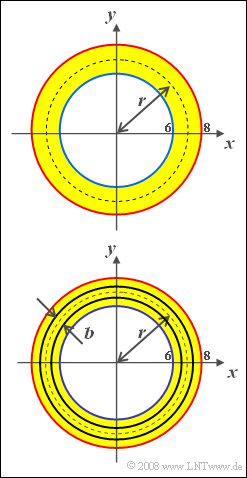Exercise 3.8Z: Circle (Ring) Area
We consider circles of different sizes:
- The radius $r$ and the area $A$ can be thought of as interdependent random variables.
- It is assumed that the radius is restricted to the area $6 \le r \le 8$ .
In the sketch above, the area in which such circles $($all with center at coordinate origin$)$ can lie is marked in yellow. Furthermore, it can be assumed that the radius in this interval is uniformly distributed:
- $$f_r(r)=\left\{ \begin{array}{*{4}{c}} 0.5 & \rm for\hspace{0.2cm}{\rm 6\le \it r \le \rm 8}, \\\rm 0 & \rm else. \end{array} \right.$$
From subtask (5) narrow circular rings with center radius $r$ and width $b$ are considered $($lower sketch$)$:
- The area of such a circular ring is denoted by $R$.
- The possible center radii $r$ are again uniformly distributed between $6$ and $8$.
- The circular ring width is $b = 0.1$.
Hints:
- The exercise belongs to the chapter Exponentially distributed random variables.
- In particular, reference is made to the page Transformation of random variables.
Questions
Solution
- From this, with $r = 6$ for the minimum value:
- $$A_\text{min} \hspace{0.15cm}\underline {= 113.09}.$$
(2) Correspondingly, with $r = 8$ for the maximum value:
- $$A_\text{max} \hspace{0.15cm}\underline {= 201.06}.$$
(3) The simplest way to solve this problem is as follows:
- $$m_{\rm A}={\rm E}\big[A\big]={\rm E}\big[g(r)\big]=\int_{ -\infty}^{+\infty}g(r)\cdot f_r(r) {\rm d}r.$$
- With $g(r) = \pi \cdot r^2$ and $f_r(r) = 1/2$ in the range of $6$ ... $8$ obtains:
- $$m_{\rm A}=\int_{\rm 6}^{\rm 8}1/2 \cdot\pi\cdot r^{\rm 2}\, {\rm d} \it r=\frac{\pi}{\rm 6}\cdot \rm ( 8^3-6^3) \hspace{0.15cm}\underline{=\rm 154.98}.$$
(4) The PDF of the transformed random variable $A$ is:
- $$f_A(A)=\frac{f_r(r)}{|g\hspace{0.05cm}'(r)|}\Bigg|_{r=h(y) = \sqrt{A/ \pi }}.$$
- In the range between $A_\text{min} {= 113.09}$ and $A_\text{max} {= 201.06}$ then holds:
- $$f_A(A)=\frac{\rm 1/2}{\rm 2\cdot \pi\cdot\it r}\Bigg|_{\it r=\sqrt{\it A/\rm \pi}}=\frac{\rm 1}{\rm 4\cdot\sqrt{\it A\cdot\rm \pi}}.$$
- The probability we are looking for is obtained by integration:
- $${\rm Pr}(A> 150)=\int_{\rm 150}^{\it A_{\rm max}}\frac{\rm 1}{\rm 4\cdot\sqrt{\it A\cdot\rm \pi}} \; \rm d \it A= \frac{\rm 2\cdot\sqrt{\it A}}{\rm 4\cdot\sqrt{\pi}}\Big|_{\rm 150}^{\it A_{\rm max}}.$$
- The upper limit of integration yields the value $4$ and the lower limit $3.455$. This yields the probability we are looking for:
- $${\rm Pr}(A> 150) \hspace{0.15cm}\underline {=54.5\%}.$$
(5) For the circular ring area $R$ holds for a given radius $r$:
- $$R=\left (r+{b}/{\rm 2} \right)^{\rm 2}\cdot \rm\pi-\left ({\it r}-{\it b}/{\rm 2} \right)^{\rm 2}\cdot \rm\pi= \rm2\cdot\pi\cdot\it r \cdot b.$$
- There is thus a linear relationship between $R$ and $r$ .
- That is: $R$ is also uniformly distributed independently of the width $b$ as long as $b \ll r$.
- For the minimum value holds:
- $$R_{\rm min}=\rm 2\pi\cdot 6\cdot 0.1\hspace{0.15cm}\underline{\approx3.77}. $$
(6) Accordingly, the maximum value is:
- $$R_{\rm max}=\rm 2\pi\cdot 8\cdot 0.1\hspace{0.15cm}\underline{\approx 5.03}.$$
(7) Due to the linear relationship between $R$ and $r$ the mean radius $r = 7$ also leads to the mean circular ring area:
- $${\rm E}\big[R\big]=\rm 2\pi\cdot 7\cdot 0.1\hspace{0.15cm}\underline{\approx 4.4}.$$
